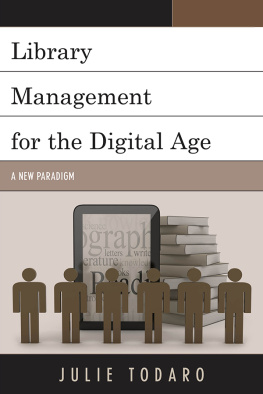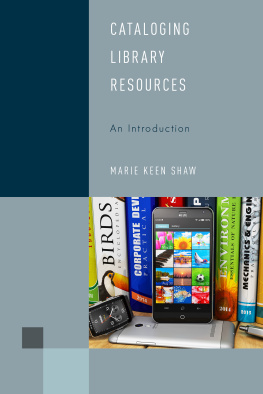
Contents
Guide
Dr. Julie Todaro is a librarian and consultant in libraries and nonprofit environments. She has managed and worked in a variety of types and sizes of libraries in her career, including academic, public, and school libraries. Her career includes academic dean and library manager, graduate school library educator, consultant, and trainer, and she has experience as a childrens librarian in a public library and is a certified all-levels school librarian. Todaro has an MSIS from the University of Texas School of Information, Austin, and a DLS from Columbia University in New York City.
She is dean of Austin Community College (ACC) with 40k+ enrollments, eleven libraries, and technical services serving seven central Texas counties and school districts. As dean of the award-winning library services, Julie manages 145+ employees, including 36 full-time faculty librarians, 30+ hourly academic librarians, 45 hourly instruction librarians, 35+ full-time classified staff, and 35+ hourly classified employees.
Julie is a frequent keynote speaker, trainer, and presenter at local, state, and national conferences and staff development days. She has presented for institutional and library administrative teams, library cooperatives, governing and advisory boards, and institutes on professionalism; general and executive management; general, executive, and association leadership; and communication, marketing, public relations, and advocacy. She has presented on mentoring for nonprofits and the role of mentorship in development and fundraising. She has consulted for all types and sizes of libraries across the country on designing organizational structures, organizational climate, and change management; designing facilities; twenty-first-century services; operational and strategic planning; communication, public relations, and marketing; community partnerships; customer service; value, benefit, worth, and impact; and measurement, assessment, and accountability.
Todaro was the Association of College and Research Libraries (ACRL) 20072008 president and the American Library Association (ALA) 20162017 president, whereas the first community college presidenther presidential initiative focused on professional expertise. At ALA, Todaro served as co-chair and member of four presidential initiatives and member and chair of ACRLs Institute for Information Literacy. Todaro received the 1996 Texas Library Association (TLA) Librarian of the Year Award and the 1999 YWCA Austin Educator of the Year Award, and she was the 2001 TLA president. She was also honored by TLA with a 2012 Lifetime Achievement Award and with the 2020 TLA Distinguished Service Award. She also received the 2005 Austin Business Journals Profiles in Power award and her LLAMA journal The Truth Is Out There column received a LLAMA certificate of recognition.
Julie has authored dozens of articles, chapters, and columnsfor all types and sizes of librariesand has written three books on emergency management (two editions), library management, and leadership and mentorship and has coauthored a handbook on customer services. Her books include Mentoring A to Z (ALA/Neal- Schuman); Library Management for the Digital Age: A New Paradigm (Rowman and Littlefield); and Emergency Preparedness in Libraries (Government Institute, with a fall 2019 second edition); and she coauthored with Texas State Librarian and Archives Commissions (TSLAC) Mark Smith Training Library Staff and Volunteers to Provide Extraordinary Customer Service (Neal-Schuman).
Her other work over the past three decades focuses on designing and using evidence-based decision-making practices and includes content on Collaborating, Partnering, Cooperating: The Good, the Bad, and the Future, Staffing Issues for the 21st Century, Integrating Learning with Work: Designing the 21st-Century Learning Library, and Cutting Edge Redux: New and Used Programs and Services with a 21st-Century Spin. Since 1994, she has been curriculum designer/presenter for the foundation content for TSLACs Small Public Library Management Series (planning, change, budgeting, marketing, etc.) and was the creator, curriculum designer, and presenter for TLAs A-to-Z Training for Support Staff 20142020 and TLAs Executive Leadership Immersion program 20162019.
I LEARNED FROM MY emergency-management research that there was and continues to be ongoing growth and change in the world of emergency-management research and information andobviouslynot only in the last decade but also significantly since the beginning of 2020. The literature of the library and information profession has also expandedin regard to emergency managementsince 9/11 somewhat, but then significantly beginning in February of 2020.
A surprising amount of information, knowledge, research, and direction about pandemics and related events is already available:
- Emergency-management print/paper resourceswhile continuing to be updatedhave newer, more focused content on pandemic content (obviously) but also on extreme emergency management in general.
- Online emergency-management resources have continued to grow, but the breadth and range of their coverage is unprecedented. Not unlike the pre-Y2K world, almost every print/paper and online resource has a COVID or pandemic column or specialist assigned to relate to and create information. Besides the rush to provide new or quick and easy access to digital content, journal content has changed. Examples include:
- A Good Housekeeping issue will have columns on cleaning spaces, cleaning vs. sanitizing, creating and maintaining work-from-home settings, and recipes for eating responsibly, and so on.
- Womens Wear Daily a trade publication of the fashion industrywill feature content on not only the impact of the pandemic on business but also sustainability of cloth and other materials likely to be used in upholstery as well as staging programs, and unique ways to offer presentations with social distancing.
- Sports Illustrated not only focuses on the effect of the pandemic on an entertainment and leisure economy but also contains articles on social distancing for crowds, safety and user bubble spaces, PPE comfort for work environments, as well as the differences in online vs. live/in-person engagement.
- Extensive government resources have been generated not only to expand government agency general information and assistance but also to identify COVID issues from each agencys perspective with a greatly expanded CDC for each stage of the pandemic and also OSHA, FEMA, Transportation, and Homeland Security, to name just a few federal agency and information centers.
- Existing commercially available products have been identified and categorized to educate on why some products are acceptable while others are not. New commercial products have been created to meet more in-depth needs. Both existing and new products, however, exist in a roller coaster of availability, credibility, and usability.
- Existing educational programs of study not only offer intensive and in-depth content on crises or emergency management in general but also have been updated for pandemic application. Programs of study have introduced new pandemic-specific and related credentials on contact tracing, sanitizing environments, and expanded content on continuity and recovery practices.
- Professions specific and related to emergency management have increased content and altered delivery to provide for shorter, updated training as well as revised credentialing for those already practicing in the field:
- risk-management associate in risk management (ARM designation);
Next page








